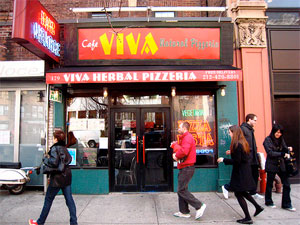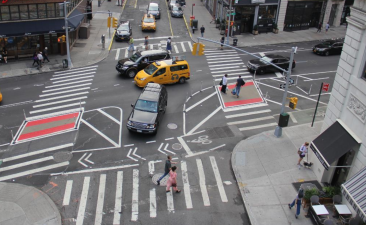What’s Good for Green Transport Is Good for Business in the East Village
 Second Avenue shoppers are far more likely to arrive via bus, bike, or foot than private car. Photo: akuban/Flickr
Second Avenue shoppers are far more likely to arrive via bus, bike, or foot than private car. Photo: akuban/FlickrWherever parking spaces are replaced with infrastructure for sustainable transportation, you can usually find a local merchant yelling about how it will destroy his livelihood. With the redesign of First and Second Avenue bringing safer biking and faster buses to their neighborhood, five NYU undergrads set out to measure what local merchants stand to lose or gain. Their findings suggest that protected bike lanes and Select Bus Service are going to be good for business in the East Village.
The overwhelming majority of shoppers along
Second Avenue walk, bike, or take transit to get there, according to the NYU students’ research, which you can look over here. Overall, shoppers who don’t arrive by private car spend more than 26 times as much as motorists at East Village businesses every week.
Employing a method recommended by Transportation Alternatives, the students conducted 500 random interviews along Second Avenue between 14th Street and Houston Street, asking people on the sidewalk how they got to the neighborhood, how often they visit, how much they normally spend in the East Village, and other questions to gauge their shopping behavior.
Their findings were striking, if unsurprising. Of the people they interviewed, 45 percent had come to the East Village by transit and another 43 percent on foot or a bike. Another five percent had taken a taxi, leaving only seven percent who took private cars.
Drivers spent much less money in the East Village than non-drivers. Interviewees who had arrived in a private car spent an average of $82.20 in the neighborhood each week. Everyone else spent an average of $154.13 a week, almost twice as much. Altogether, drivers spent only $2,712 of the $74,690 that the interview subjects spent in the neighborhood weekly, making them a rather small fraction of merchants’ bottom line.
The students’ findings echo those of a 2006 study of SoHo shoppers by Bruce Schaller. That study, also based on sidewalk interviews, found that almost no SoHo shoppers were arriving by car and that transit riders, pedestrians and cyclists tended to be the big spenders.
The NYU report did find that, per trip, drivers spent more money in the East Village than shoppers who arrived by other means. That might help explain why some local merchants believe that parking is so important, even while the overwhelming majority of their business comes from people who take transit, walk, and bike. However, this argues for implementing performance parking measures in conjunction with Select Bus Service and street safety enhancements. Together those changes would generate more foot traffic from sustainable modes and increase parking turnover while reducing congestion caused by shoppers cruising for spots.
The students certainly see the conclusion of their research as unambiguously pro-transit. "We recommend that businesses support the [East Side] project," they write, "and we recommend that Community Board 3 specifically, and community board 6, 8, and 11 more broadly, vote in favor of the project."
